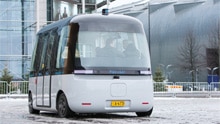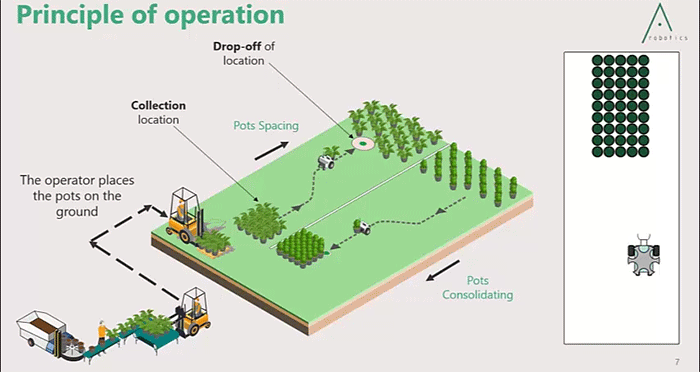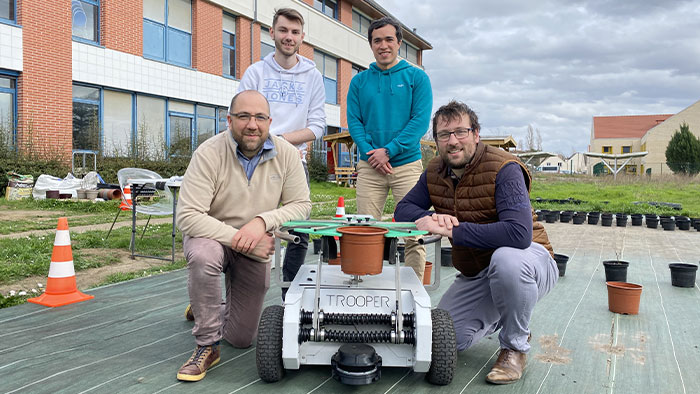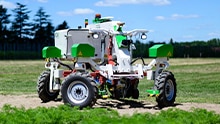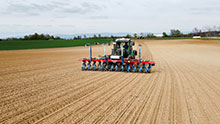To ensure plants grow optimally, pots weighing up to 10 kg in a tree or garden nursery need to be moved and rearranged regularly – each and every day. It’s arduous and strenuous work, so it’s good that visionaries like Pierre Delarboulas and Adrien Jauffret from Instar Robotics in France exist. Their “Trooper” autonomous robot takes care of transporting the potted plants and contributes to automation in the horticultural industry. The MRS1000 3D LiDAR sensor ensures accurate navigation and environment perception in this harsh environment.
Super Trooper: Autonomous robot helps gardeners transport potted plants
Instar Robotics is a young start-up company that was founded in 2018 by Pierre Delarboulas and Adrien Jauffret. They each have doctorates in the scientific fields of artificial intelligence and robotics and have had a long-time interest in robotics. Their mission: practical robotics that help humans in their everyday life and let them focus on their profession again.
Helping tree nurseries transport potted plants
The founders had the desire to work in farming from a young age. This industry, in particular, poses numerous technical challenges on robotics. The conditions in outdoor applications are extremely variable and constantly changing (environment, weather, ground...). It was therefore necessary to develop robots that are adaptable, flexible and reliable.
After extensive research, the two scientists came across the horticultural sector and the transporting of potted plants there – a predominantly manual, frequently recurring, and physically very strenuous job. Furthermore, these tasks were mainly performed by seasonal workers who are becoming increasingly hard to find due to the difficult conditions. All the prerequisites for developing a robotic solution to relieve the workers were therefore present.
Two of the tasks in a tree nursery are particularly important for the quality of the plants: placing them either closer or further apart. The former is done at the start of planting in order to optimize the available space. In the preparation phase and during potting, the pots are arranged next to each other “in rectangles” and “on the hall floor” to support the initial growth phase. After a certain time, the pots are then transported individually to a different location in the nursery. This enables the plants to thrive and stops the spread of diseases. Some nursery operations are several hundred hectares in size and move more than 100,000 pots that can weigh up to 10 kg each. You can therefore imagine how this highly repetitive task could benefit from an automation solution.
Development of a handling robot for relieving tree nurseries
It therefore made sense to develop a small, autonomous robot to help gardeners and tree nurseries transport pots from A to B within their operation and to place them either close together or further apart – and so Trooper was born.
What quickly emerged was the problem of environment perception. The robot needs to be able to:
- move about independently,
- understand its environment,
- recognize hindrances,
- recognize the pots,
- position itself correctly to grasp them,
- orient itself,
- and do all of this in a safe manner and in collaboration with humans.
It therefore made good sense to use a 3D LiDAR sensor – and, in the end, Instar Robotics chose the MRS1000 multi-layer scanner.
The “eyes” of the Trooper for environment perception
The MRS1000 is a multi-layer scanner and, so to speak, “the eyes of the Trooper”, says Pierre Delarboulas. It generates a point cloud that provides the distance to the object, which is then used to calculate the route, and can also be used to model a reconstruction of the objects. An algorithm developed by Instar Robotics recognizes the objects by searching for circles (i.e. pots) that were reconstructed with the help of the point cloud and four layers of the LiDAR sensor.
The sensor also determines the reflection factor of the object, which makes it easier to distinguish the objects by their color. This increases the responsiveness of the robot: It makes better decisions and interacts appropriately with the environment.
Great success thanks to the capabilities of the 3D LiDAR sensor
The performance of the MRS1000 was one of the key factors in the success of the project. It detects and measures objects within a field of view of 275°. The ability of the MRS1000 to take simultaneous measurements on four different levels enables it to detect objects in detail and to track their direction of movement. The rugged housing is dust, heat, and moisture resistant and, thanks to the HDDM+ technology, also especially reliable and efficient even in fog or strong light – and therefore met all of Instar Robotics’s requirements.
Savings of 15 percent for nursery operations
The horticulturalists agree: “There’s before the Tropper, and there’s after the Trooper,” says Pierre Delarboulas. There was a glaring lack of workers in this sector, in particular due to the strenuous work of placing the pots closer together or further apart. Thanks to the robot, the employees are now relieved from this task and have more time and peace to dedicate themselves to more demanding and motivating tasks.
The project also paid off in regard to productivity. The robot is never tired, works in any weather, and places the pots in the optimal location. This saves up to 15% of the working area in the nurseries.
It takes about four to five years to amortize the investment in a Trooper, depending on the machine utilization rate. This is a relatively short time for an investment in the agricultural sector.
“There is always someone to support us”

These are the words of Pierre Delarboulas regarding the various SICK teams in France. The Trooper was incrementally designed and continuously improved in collaboration with SICK. For example, the sensor was initially very vulnerable to external conditions (rain, earth) due to its position on the robot. It needed to be shielded with a customized hood. After an investigation by the SICK team, the most compact protection was designed in order to achieve an even better performance. The collaboration was very fulfilling for both parties.
And what does the future hold?
There is no lack of ideas for new products. Three new tools are currently being developed to extend the capabilities of the Trooper and address the issue of a labor shortage in the horticultural industry:
- The cutting and pruning of plants
- Pest control by wrapping plants with adhesive strips
- Soil treatment, for example by uniformly distributing fertilizer around the plant in the pots
Read more
